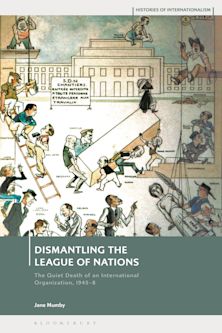- Home
- ACADEMIC
- Politics & International Relations
- International Relations - Other
- Creating the Third Force
Creating the Third Force
Indigenous Processes of Peacemaking
Hamdesa Tuso (Anthology Editor) , Maureen P. Flaherty (Anthology Editor) , Lobar Azizova (Contributor) , Nodira Azizova (Contributor) , Bruce Barnes (Contributor) , Paul Cormier (Contributor) , Maureen P. Flaherty (Contributor) , Ali Gohar (Contributor) , George Emile Irani (Contributor) , Marianne Kamp (Contributor) , Marion J. Kiprop (Contributor) , Sandra Krahn (Contributor) , Grace Kyoon-Achan (Contributor) , J. P. Linstroth (Contributor) , Roger Mac Ginty (Contributor) , Federico V. Magdalena (Contributor) , Javier Mignone (Contributor) , Joshia Osamba (Contributor) , Yogendra P. Paneru (Contributor) , Everard Phillips (Contributor) , Christy Reed (Contributor) , Cathy Rocke (Contributor) , Lisa Schirch (Contributor) , Stephanie Phetsamay Stobbe (Contributor) , Martha Maria Wospakrik (Contributor) , Zulfiya Tursunova (Contributor) , Hamdesa Tuso (Contributor) , John Harold Gómez Vargas (Contributor) , Flora Zaharia (Contributor)
Creating the Third Force
Indigenous Processes of Peacemaking
Hamdesa Tuso (Anthology Editor) , Maureen P. Flaherty (Anthology Editor) , Lobar Azizova (Contributor) , Nodira Azizova (Contributor) , Bruce Barnes (Contributor) , Paul Cormier (Contributor) , Maureen P. Flaherty (Contributor) , Ali Gohar (Contributor) , George Emile Irani (Contributor) , Marianne Kamp (Contributor) , Marion J. Kiprop (Contributor) , Sandra Krahn (Contributor) , Grace Kyoon-Achan (Contributor) , J. P. Linstroth (Contributor) , Roger Mac Ginty (Contributor) , Federico V. Magdalena (Contributor) , Javier Mignone (Contributor) , Joshia Osamba (Contributor) , Yogendra P. Paneru (Contributor) , Everard Phillips (Contributor) , Christy Reed (Contributor) , Cathy Rocke (Contributor) , Lisa Schirch (Contributor) , Stephanie Phetsamay Stobbe (Contributor) , Martha Maria Wospakrik (Contributor) , Zulfiya Tursunova (Contributor) , Hamdesa Tuso (Contributor) , John Harold Gómez Vargas (Contributor) , Flora Zaharia (Contributor)
You must sign in to add this item to your wishlist. Please sign in or create an account
Description
The profession of peacemaking has been practiced by indigenous communities around the world for many centuries; however, the ethnocentric world view of the West, which dominated the world of ideas for the last five centuries, dismissed indigenous forms of peacemaking as irrelevant and backward tribal rituals. Neither did indigenous forms of peacemaking fit the conception of modernization and development of the new ruling elites who inherited the postcolonial state. The new profession of Alternative Dispute Resolution (ADR), which emerged in the West as a new profession during the 1970s, neglected the tradition and practice of indigenous forms of peacemaking. The scant literature which has appeared on this critical subject tends to focus on the ritual aspect of the indigenous practices of peacemaking. The goal of this book is to fill this lacuna in scholarship. More specifically, this work focuses on the process of peacemaking, exploring the major steps of process of peacemaking which the peacemakers follow in dislodging antagonists from the stage of hostile confrontation to peaceful resolution of disputes and eventual reconciliation. The book commences with a critique of ADR for neglecting indigenous processes of peacemaking and then utilizes case studies from different communities around the world to focus on the following major themes: the basic structure of peacemaking process; change and continuity in the traditions of peacemaking; the role of indigenous women in peacemaking; the nature of the tools peacemakers deploy; common features found in indigenous processes of peacemaking; and the overarching goals of peacemaking activities in indigenous communities.
Table of Contents
CHAPTER 2: “The Best of Judgments”: Rituals of Settlement (Sulh) and Reconciliation (Musalaha) in the Middle East
CHAPTER 3: Araraa: The Oromo Indigenous Processes of Peacemaking
CHAPTER 4: Respecting Identity, Creating Justice, and Building Peaceful Relationships in Laos through Traditional Conflict Resolution Processes
CHAPTER 5: Indigenous Peacemaking in Northern Ireland
CHAPTER 6: Traditional Systems of Conflict Mediation: Exploration of Mukhiya or Jimmuwal, and Bhadra-Bhaladmis Peacemaking Mechanisms in the Himalayas
CHAPTER 7: Case Study: Peacemaking as Ceremony: The Mediation Model of the Navajo Nation
CHAPTER 8: Indigenous Elders as the Mbasoron Tar (Repairers of the World) and Inukshuks (Waypointers) of Peace
CHAPTER 9: Traditional Peacemaking Processes among Indigenous Populations in the Northern and Southern Philippines
CHAPTER 10: Kinoo'Amaadawaad Megwaa Doo
Product details
| Published | 21 Nov 2016 |
|---|---|
| Format | Ebook (Epub & Mobi) |
| Edition | 1st |
| Extent | 586 |
| ISBN | 9780739185292 |
| Imprint | Lexington Books |
| Illustrations | 5 tables; |
| Series | Peace and Conflict Studies |
| Publisher | Bloomsbury Publishing |
About the contributors
Reviews
-
This volume makes an important contribution in allowing the intellectual community to ‘rediscover’ indigenous peacemaking processes and (re)consider alternative approaches to addressing conflict, as well as managing the increasing diversification and fragmentation of our societies.
South African Journal of International Affairs
-
Creating the Third Force is a welcome addition to the growing literature on peacebuilding and conflict management. The volume advances, broadens, and deepens our knowledge of indigenous peacebuilding and conflict management. It demonstrates the efficacy of indigenous peacebuilding tools including storytelling, proverbs and metaphors, rituals and symbols, collaborative social systems, and deployment of visual and performing arts.
Akanmu G. Adebayo, Kennesaw State University
-
This volume provides a valuable and timely service to the comparative study of the new Western-based field of conflict and peace studies by emphasizing indigenous processes of conflict resolution from across the world. By opening a window into the peculiarities of the human experience of conflict and peacemaking processes that have a long history in indigenous societies in many parts of the world, the volume brings forth new perspectives in conflict and peace studies.
Fonkem Achankeng, University of Wisconsin Oshkosh
-
Creating the Third Force brings to light a novel approach by delving into the oft-neglected role of indigenous culture, cosmology and methods of conflict resolution. This beautifully written, organized, and timely book will make an immense contribution to the field of conflict resolution and is indispensable read for students, scholars, practitioners and policy makers as well as those who are engaged in an arduous task of peace-making and peace-building to achieve lasting peace.
Abbas H. Gnamo, University of Toronto

ONLINE RESOURCES
Bloomsbury Collections
This book is available on Bloomsbury Collections where your library has access.



































